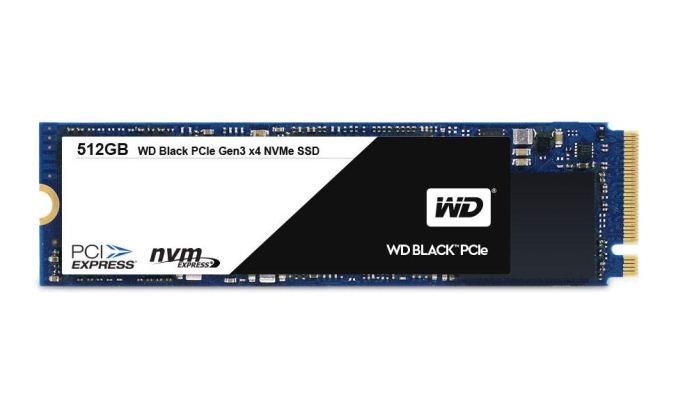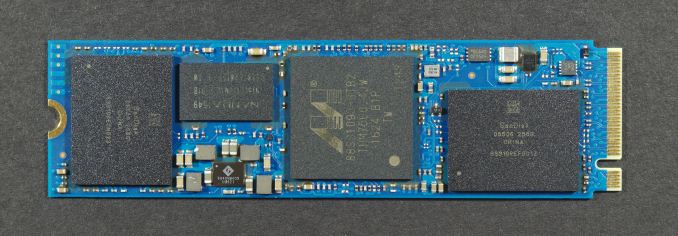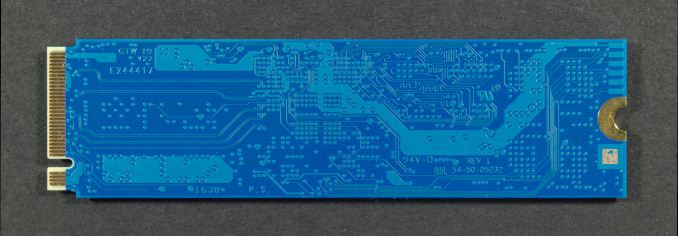The Western Digital Black PCIe SSD (512GB) Review
by Billy Tallis on March 8, 2017 8:30 AM EST
After acquiring SanDisk and introducing WD Green and WD Blue SSDs, it is no surprise to see Western Digital introduce a WD Black SSD that is a M.2 PCIe drive. In keeping with SanDisk's recent trends for mainstream consumer SSDs, the WD Black uses a Marvell controller (the 88SS1093, also seen in the Plextor M8Pe) and uses SanDisk's 15nm TLC NAND flash. And yes, the blue PCB is another SanDisk hallmark, even though it clashes with Western Digital's branding for the drive.
Western Digital and SanDisk are relatively late in bringing a consumer NVMe SSD to market. They're clearly intending for the WD Black SSD to be a fairly mainstream product by using TLC NAND and pricing it below high-end SATA SSDs. In the SATA space SanDisk has made very effective use of their planar TLC and the SanDisk X400 and WD Blue are the best in their class. Having taken their time developing the WD Black, we expect another solid performer. However, time is running out for planar TLC the WD Black may turn out to be a short-lived product before being replaced by a successor with 3D NAND. All four major NAND manufacturers plan to ship 64+ layer 3D NAND this year with TLC parts up to 512Gb, and if things go according to plan for at least two or three of them we should see the NAND shortage start to fade and prices and capacities improve.
| WD Black PCIe SSD Series Specifications | |||
| Capacity | 256GB | 512GB | |
| Form Factor | M.2 2280 | ||
| Interface | PCIe 3.0 x4 NVMe | ||
| Controller | Marvell 88SS1093 | ||
| NAND | SanDisk 15nm TLC | ||
| Sequential Read | 2050 MB/s | ||
| Sequential Write | 700 MB/s | 800 MB/s | |
| Random Read (4 KB) IOPS | 170k | 170k | |
| Random Write (4 KB) IOPS | 130k | 134k | |
| Power | Peak | 8.25 W | |
| Idle | 5.5 mW | ||
| Endurance | 80 TBW | 160 TBW | |
| Encryption | none | ||
| Warranty | 5 years | ||
| MSRP | $109 | $199.99 | |
The WD Black comes in only the two capacities that should be most popular: 256GB and 512GB. A 128GB PCIe SSD risks squandering much of the advantage of the faster interface due to the low number of NAND dies being a bottleneck, and 1TB PCIe SSDs are still expensive enough to be substantially less popular. A 1TB version would also need to be a double-sided M.2 module, which would limit compatibility with some laptops. As expected for a TLC SSD, the rated read performance is much higher than the write performance, though Western Digital does still give the WD Black a very nice looking random write rating. The endurance ratings for the WD Black are a little lower than I'd like to see given that even a TLC-based PCIe SSD is something of a premium product, but the five year warranty is quite reasonable.
Western Digital is currently taking pre-orders for the WD Black at MSRP and projecting a ship date of March 14, while there are already some third-party Amazon sellers offering it above MSRP. The MSRPs are about 10% higher than the current prices for the Intel SSD 600p, the current cheapest and slowest PCIe SSD.
For this review we will be comparing the 512GB WD Black primarily against other PCIe SSDs of similar capacity, and against a handful of the better SATA SSDs currently on the market. Some specific competitors to keep an eye on:
- The Plextor M8Pe uses the same Marvell controller and Toshiba's 15nm MLC counterpart to the 15nm TLC used by the WD Black.
- The WD Blue uses the same NAND as the WD Black, but a Marvell SATA SSD controller instead of the PCIe NVMe controller.
- The Intel SSD 600p based on Intel 3D TLC NAND and Silicon Motion's SM2260 controller is currently the cheapest and slowest NVMe SSD.
- The Samsung 960 EVO is the TLC PCIe SSD that's positioned above the WD Black in the market, and is the more mainstream of Samsung's current NVMe offerings.
| AnandTech 2015 SSD Test System | |
| CPU | Intel Core i7-4770K running at 3.5GHz (Turbo & EIST enabled, C-states disabled) |
| Motherboard | ASUS Z97 Pro (BIOS 2702) |
| Chipset | Intel Z97 |
| Memory | Corsair Vengeance DDR3-1866 2x8GB (9-10-9-27 2T) |
| Graphics | Intel HD Graphics 4600 |
| Desktop Resolution | 1920 x 1200 |
| OS | Windows 8.1 x64 |
- Thanks to Intel for the Core i7-4770K CPU
- Thanks to ASUS for the Z97 Deluxe motherboard
- Thanks to Corsair for the Vengeance 16GB DDR3-1866 DRAM kit, RM750 power supply, Carbide 200R case, and Hydro H60 CPU cooler












36 Comments
View All Comments
Gothmoth - Wednesday, March 8, 2017 - link
why would anyone buy this?if you want M.2 you want performance.. this is just crap.
GoMoeJoe - Wednesday, March 8, 2017 - link
Price according to mediocre performance.Glad to see WD entering the space though.
WinterCharm - Wednesday, March 8, 2017 - link
Horrible price to performance ratio... if you're going to gimp reads this much on an M.2 SSD, then at least give us 1TB for $200.herbc - Wednesday, March 8, 2017 - link
Noticed top end SATA 2.5 inch SSD's jumped in price considerably lately. Samsung 850 Pro 256 GB went from $129.00 to around $150.00 in a week.Magichands8 - Wednesday, March 8, 2017 - link
Pretty much none of these SSDs are worth buying until the prices get down to around $0.12/GB and even then with a proper form factor. I suppose if you're particularly desperate or require them for some special niche use-case they will serve a purpose, ignorance not withstanding, but otherwise I just don't see the point.TheinsanegamerN - Thursday, March 9, 2017 - link
At 39c/GB, most people are already seeing that SSDs are far superior to HDDs for a majority of use cases.Jad77 - Wednesday, March 8, 2017 - link
It's Blue, not Black.Makaveli - Wednesday, March 8, 2017 - link
I don't get WD they may performance competitive drives in the spinning HD space. Yet when is comes to SSD's and M.2, NVMe drives they are happy with being bottom feeders!I guess its probably "a day late a dollor short" meaning it took them so long to enter the market everyone else was already so far ahead.
creed3020 - Thursday, March 9, 2017 - link
That has been WD's slogan and approach to SSD based storage for years. We've been saying for years that HDD's relevancy will continue to shrink and if these giants want to survive into tomorrow then they need to innovate, which this product is clearly not an example of. Its barely an also ran.CoreLogicCom - Wednesday, March 8, 2017 - link
They just don't want to cannibalize the last remnants of their consumer hard drive business by producing SSDs that are faster than their hard drives...?